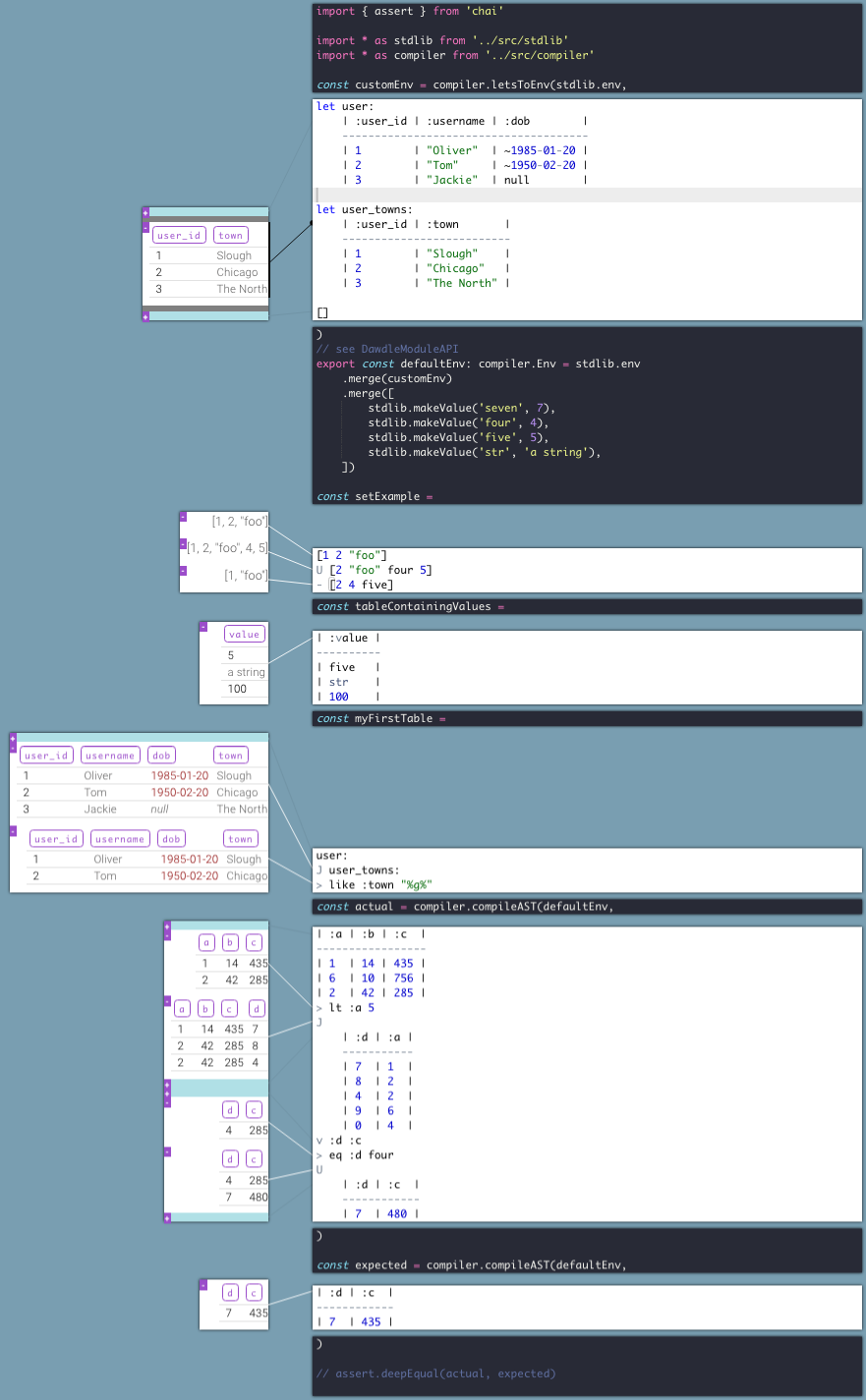Dawdle is a relational DSL that I played around making in 2018, the aim was to explore some stuff surrounding relational theory and building an interpereter - hence a lot of the code is questionable quality. Hopefully, you can get things running with:
cd radslam
npm run bundle -- --mode development # --watch
npm run ts -- src/server.ts
google-chrome http://localhost:3000/?path=examples/example_3.dawdle.ts(what self-respecting DSL project doesn't come with an IDE...)
relations are in the formsome_relation:headers are in the form:some_header- plain ol' sets are in the form
["a-str" 5 :some_header] - the literal types supported are the JSON types, plus:
- datetimes in the form
~some-ISO-8601 - decimals in the form
$1.05 - templates in backticks with
{{}}interpolation
- datetimes in the form
- the columns themselves are not typed, it is up to the host language to enforce.
Now some relational operations, we have:
>filtervselect^extendXcrossUunion-differenceJjoinGgroup
> v ^ are pictographic, X U - also operate on sets
Also, notice the indented relation literal after the joins. Indented sections are appended to the args of the operation above them.
- Each line of dawdle should map deterministically both ways to the JSON AST
- Given an environment, it should always be possible to determine the schema (ie. the headers) at any line
- Operation lines are ordered, but don't have to be executed in a ordered way, it's up to the host language (which could for example compile the query to SQL)
- Given test values, it should always be possible to determine the value at any line of a top level let or section
- Composite operators can only be composed of the base operators and other composite operators
- Sets are splatted in place when called with relation operators
jira_ticket:
> like :ticket "INTEG%"
> equals :issuetype "Task"
> ilike :summary `%{{oem}}%{{release}}%tracking ticket%`
^ :rank order :created
def Rename relation: old new
let final_headers
relation:*
- old
U new
relation:
^ new identity old
v final_headers
def Namespace relation: namespace ignore
let to_rename
relation:*
- ignore
relation:
(map to_rename) `Rename {{_}} {{namespace}}.{{_}}`
let counts_seen:
run:
v :run_id groups
> in :run_id
reverse_indexed_in_groups:
> lte :n max_n_runs
v :run_id
J
result:
v :run_id :result_id :duration
G :run_id
:number_of_results count :result_id
:total_duration sum :duration
Not sure this outer join definitition is even correct looking at it now..
def Outer relation: right:
let joined:
relation:
J right:
let just_right_headers
right:*
- relation:*
relation:
-
joined:
v relation:*
X
right:
> first
v just_right_headers
(map just_right_headers) `^ {{_}} make_null`
U joined:
let not_foo
[:left_id]
U [:l]
let left:
| :left_id | :l | :nah |
------------------------
| 1 | 10 | 9 |
| 2 | 20 | 9 |
| 3 | 30 | 9 |
^ :foo value 8
left:
v :left_id :l :foo
v not_foo
Outer
| :right_id | :left_id | :r |
-----------------------------
| 1 | 1 | 11 |
| 2 | 1 | 12 |
| 3 | 2 | 23 |
^ :new_header value 9
should give:
| :left_id | :l | :right_id | :r | :new_header |
--------------------------------------------------
| 1 | 10 | 1 | 11 | 9 |
| 1 | 10 | 2 | 12 | 9 |
| 2 | 20 | 3 | 23 | 9 |
| 3 | 30 | null | null | 9 |
I had some thoughts about how one might return nested relationship-y results:
relation:
-[]-
-[basket basket_discount:
]-join basket__discount:
-[discount discount:
-[purchase purchase:
-[product product:
I can't fully remember what this was meant to do, but -[ and ]- represent one-to-many and many-to-one.
